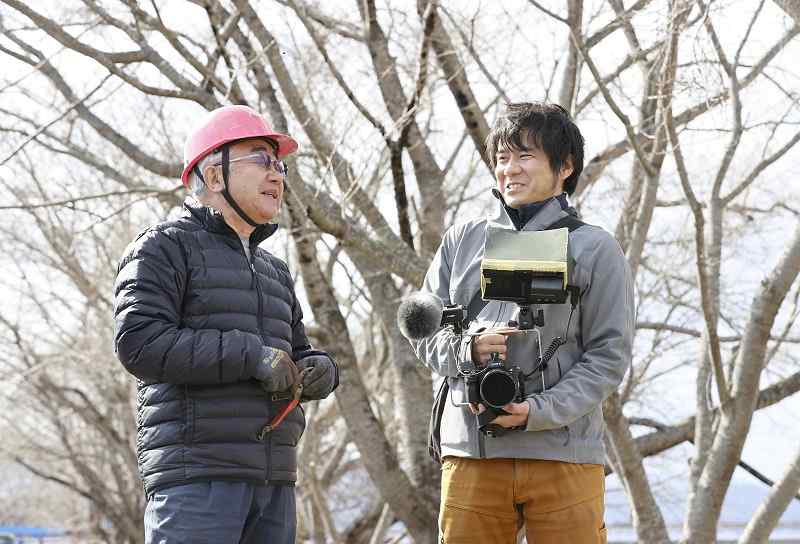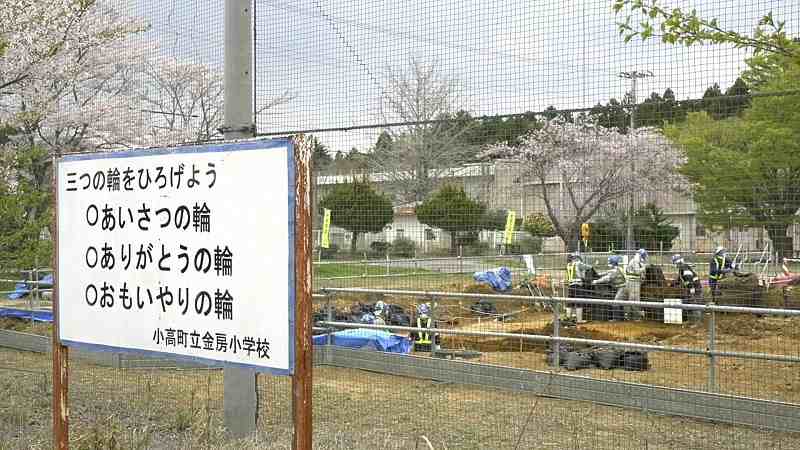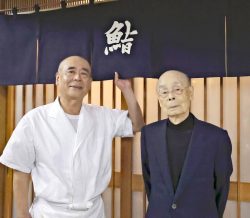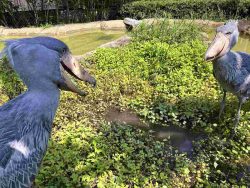
Takashi Hokoi, right, and Yuichi Harada talk amid cherry trees on March 6 in Namie, Fukushima Prefecture.
10:46 JST, March 15, 2022
NAMIE, Fukushima — The schoolyard of an elementary school is empty of children, with only rusted playground equipment left on the barren soil. An elderly man looks wistfully around the shrine with cherry blossoms in full bloom.
“During cherry blossom season, children used to come here on field trips,” he says.
It is a scene from a 2016 documentary that chronicled the lives of people in Fukushima Prefecture affected by the March 2011 disaster in the context of the cherry blossom viewing season.
Titled “Fukushima Sakura Kiko” (Fukushima cherry blossom travel story), it was filmed in the spring of 2015 in the Odaka district of Minami-Soma, Fukushima Prefecture, by Takashi Hokoi, a former NHK news cameraman who currently is pursuing a career as an artist based in Fukushima.
The Odaka district, about 15 kilometers north of Tokyo Electric Power Company Holdings, Inc.’s Fukushima No. 1 nuclear power plant, was still under an evacuation order at the time.
Seven years have passed since Hokoi, now 37, shot the documentary.
“I can hear the sound of a lawn mower,” Hokoi said with a slight smile when he revisited the district earlier this month.
With the evacuation order lifted, there are signs of life again, such as windows with open curtains. He knows that many people have not yet returned, but it is a welcome change.
The documentary was widely shown when it was released. However, Hokoi has a much more well-known video to his name, one that was circulated all over the world.
It was also one of the reasons that Hokoi left the world of journalism.
A foaming tsunami wave powers upstream in a river and floods the Sendai Plain. Houses and cars are instantly swallowed up by the wall of water.
The scene was broadcast live from an NHK helicopter at about 3:50 p.m. on March 11, 2011. Recording the destruction was Hokoi, who was in his first year as a cameraman.
Hokoi was working for the NHK Fukushima broadcasting station. He was at Sendai Airport on the day of the disaster. From an NHK helicopter, he was dumbstruck by the scene below and aimed his camera to the ground.
Tsunami waves crashed over main roads and swirled around, and houses were washed away or on fire. As he tried to come to grips with the reality-defying scene, one thought pervaded his mind: There must be people in those houses, in those cars.
The shocking video was given an award by the Japan Newspaper Publishers and Editors Association in September 2011. But Hokoi felt guilty receiving such praise. “All I did was escape to a safe place and film what I was told to,” he thought.
In 2013, NHK spoke to him about a transfer. But he decided to resign, and remained in Fukushima. He had a sense of guilt about leaving the disaster-hit area just two years after shooting such scenes and seeing its future as somebody else’s problem.
After leaving NHK, the idea for the documentary featuring cherry blossoms and people in Fukushima Prefecture came to him, all because of one person he had known.
Yuichi Harada was the third-generation owner of a clock shop and chairman of a local chamber of commerce and industry in the town of Namie, Fukushima Prefecture. In 2014, while Hokoi was planning to create a video about the disaster at the request of his university, Harada guided him around the town, which was still under evacuation orders.

A shot from the documentary “Fukushima Sakura Kiko” of an elementary school in Fukushima Prefecture where decontamination work was underway
Harada, now 72, had evacuated to the city of Nihonmatsu to the west, where he organized a community of displaced Namie residents and negotiated with TEPCO over compensation. All the while, he also continued tending to cherry trees along a river in Namie with other volunteers.
“If someone returns to the town and the cherry trees in bloom bring back memories, it might change how they feel,” Harada said.
That really hit home for Hokoi, that someone who had lost their beloved hometown could be so optimistic, believing that one day it would return.
Hokoi decided to depict present-day Fukushima through cherry blossoms, the symbol of spring and hope.
Since this spring, Hokoi has been working on a sequel to “Sakura Kiko.” He is motivated because, while interest in Fukushima Prefecture may be fading, the situation there is now more complicated.
Harada continues to look after the cherry trees today. As people could not return to Namie, he was never able to restart his business, and his store was torn down about six years ago.
The evacuation order for his hometown has since been lifted, but Harada has given up on ever returning to Namie. He thinks about moving to Ibaraki Prefecture, where his eldest daughter lives, but his mother, now in her 90s, wants him to stay in Nihonmatsu.
“Life is hard, isn’t it?” Harada said with a sad smile as he gazed at the cherry trees with Hokoi.
The strength of our desires does not necessarily make them come true. That is the harsh reality of disasters. “I want to continue following the lives of people in Fukushima Prefecture and try to find what reconstruction really means,” Hokoi said.
He will continue to face the disaster head-on.
Evacuation orders
Soon after the nuclear accident at the Fukushima No.1 nuclear power plant, the government designated an area within a 20-kilometer radius as a “warning zones” (evacuation order zones).
Areas outside that zone experiencing high levels of radiation were designated as “planned evacuation zones,” and the government demanded that residents in both zones evacuate.
The range of evacuation orders as of April 2012 extended to all or part of 11 municipalities, but that number has since decreased to the present-day seven.
Within those seven municipalities are areas designated as “difficult-to-return zones,” some of which are being developed as key reconstruction bases to provide a foothold for returning residents.
Related Tags
"Features" POPULAR ARTICLE
-

Sanrio to Open Museum in Yamanashi Pref. Dedicated to Founder, Exhibits Include Hello Kitty, Other Characters
-

Legendary Sushi Chef Jiro Ono Turns 100: ‘I Have No Regrets’
-

Autumn Foliage Surrounds Visitors to Tokyo’s Showa Kinen Park
-

My Daughter No Longer Speaks to Me, But I Want to See Her and My Grandchild
-

Kumamoto: Public Bath Refurbished as Library Where You Can Chat, Take Photos
JN ACCESS RANKING
-

Keidanren Chairman Yoshinobu Tsutsui Visits Kashiwazaki-Kariwa Nuclear Power Plant; Inspects New Emergency Safety System
-

Imports of Rare Earths from China Facing Delays, May Be Caused by Deterioration of Japan-China Relations
-

University of Tokyo Professor Discusses Japanese Economic Security in Interview Ahead of Forum
-

Japan Pulls out of Vietnam Nuclear Project, Complicating Hanoi’s Power Plans
-

Govt Aims to Expand NISA Program Lineup, Abolish Age Restriction
























